Yesterday’s live coverage of the Ukraine conflict can be found here. An archive of our liveblogs can be found here. For an overview and analysis of this developing story see our latest podcast.
Please help The Interpreter to continue providing this valuable information service by making a donation towards our costs.
For links to individual updates click on the timestamps.
For the latest summary of evidence surrounding the shooting down of flight MH17 see our separate article: Evidence Review: Who Shot Down MH17?
The Russian Defense Ministry’s TV Zvezda broadcast a program today with the headline “Grads and Uragans Rain Down on Civilian Quarters in Donetsk.”
The story was not only on Zvezda, but plastered all over Russian state and Russian-backed separatist media today.
Referring to the self-proclaimed “Donetsk People’s Republic” (DNR),
the Zvezda anchorman says that “according to DNR intelligence,”
Ukrainian armor was spotted in the town of Karakhovo headed toward
Donetsk.
But the image on the cover of the video in fact didn’t come from Kurakhovo or Donetsk nor was it taken this year; it’s an image from the Ukrainian Defense Ministry’s web site on April 20 last year, taken from a training exercise in Chernihiv Region — not an area of combat.
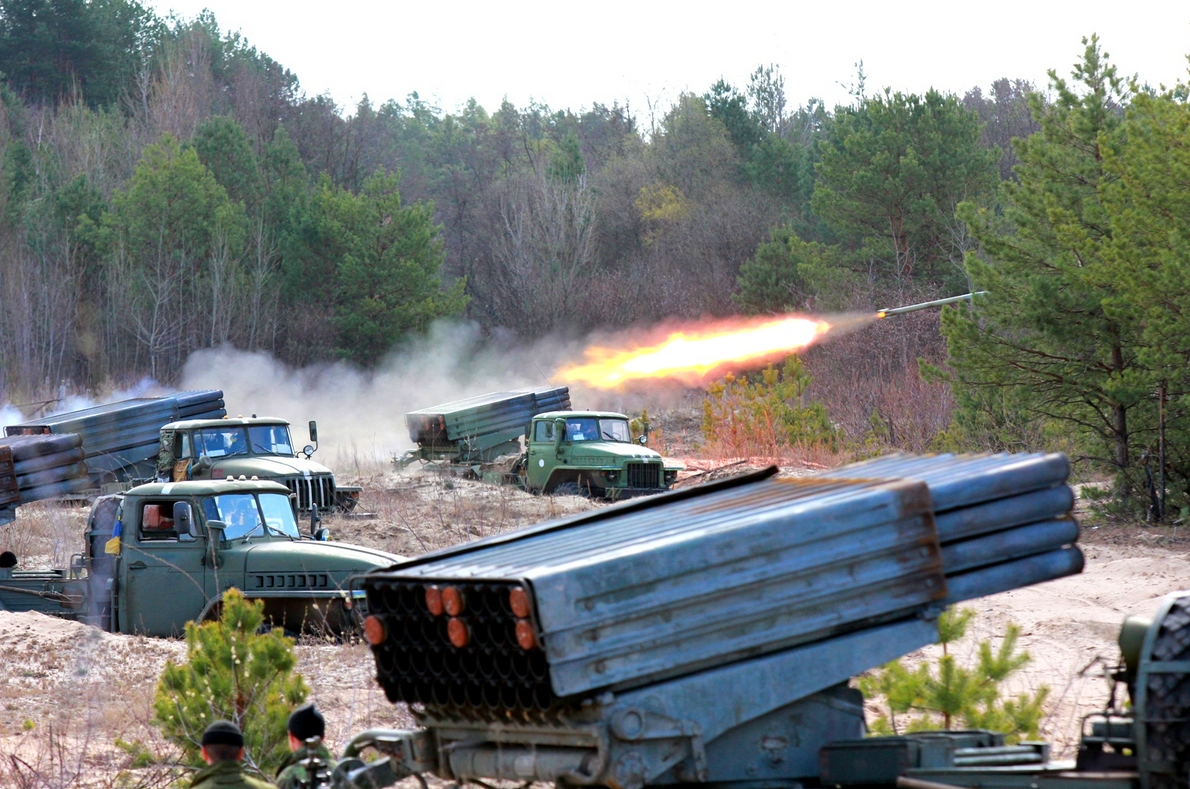
Misleading covers like this get put on videos all the time from both sides of the conflict, and it’s also common for media anywhere to use stock photos that may not illustrate the current story. TV Zvezda did put a line of credit at the end of their story “mil.gov.ua” without explaining what it was about.
State media might be forgiven for stock photos, but then there’s the video footage accompanying the news story which is even more misleading.
The program is made up of three sets of video footage, none of which are identified, but serve as the background to the narration about Ukraine supposedly sending Grad trucks to Donetsk and making the charge that Ukraine deliberately fired on civilian areas, a frequent refrain of state media.
If the TV Zvezda video is plugged into Amnesty International’s “Citizen Evidence” web site, which enables the user to see a video’s meta data and perform image searches with frames from the video, nothing will be found except the Chernihiv training photo. The images automatically selected don’t turn up anything in search.
Even if you clip one of the frames to look for a separate video, it won’t turn up results because the video has been cropped and text and a logo clutter up the screen.
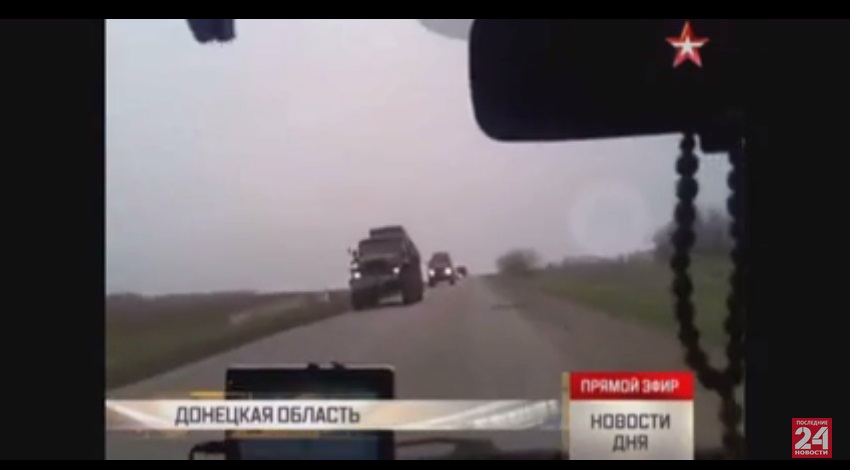
A scene with a tank is blurry and goes by quickly and can’t be found in Google search.
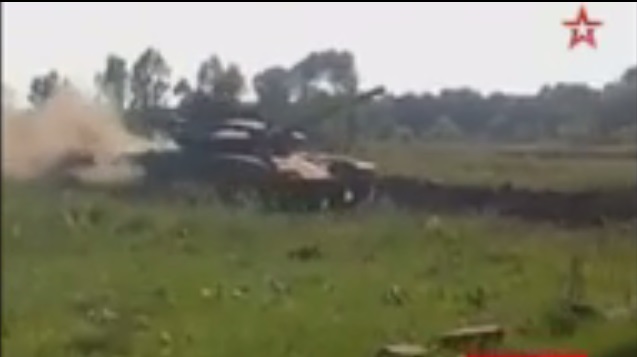
Only if you clip out a part of the scene and use various key words can you come up with a screenshot of the same video on a pro-Russian blog — from last year.
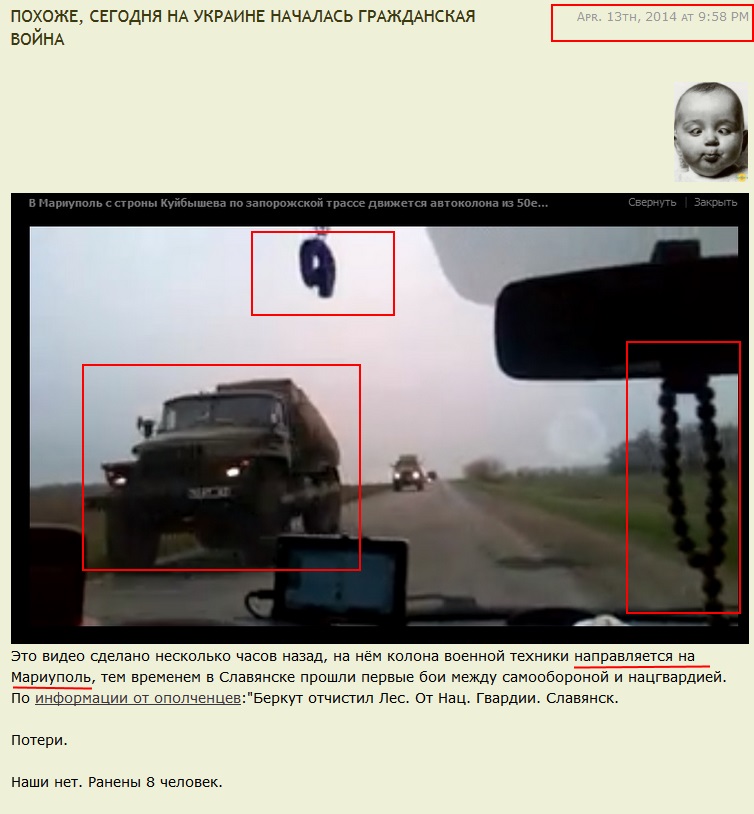
But the link to the video from which it was taken shows the video has been deleted — a common occurrence.
We searched again with the title and eventually the video was turned up — and we can see how it’s the same footage with the dangling rosary and the oncoming armor, only cropped differently:
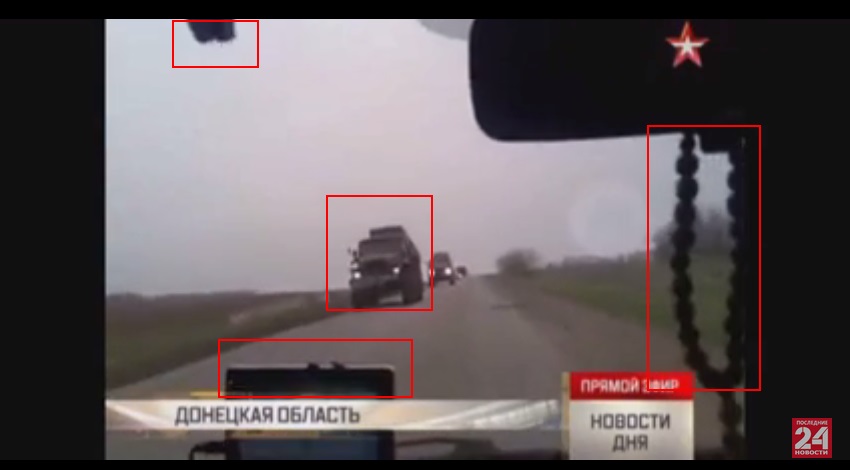
This video was uploaded April 13, 2014 and is labelled, “Tanks, BTRs Heading Toward Mariupol From Kuybyshev.”
In the video, one of the two Russian-speaking men talking says that they are about 60 kilometers from Mariupol, and both of them swear at the convoy. It’s a Ukrainian convoy, as Ukrainian flags can be seen on the armor.
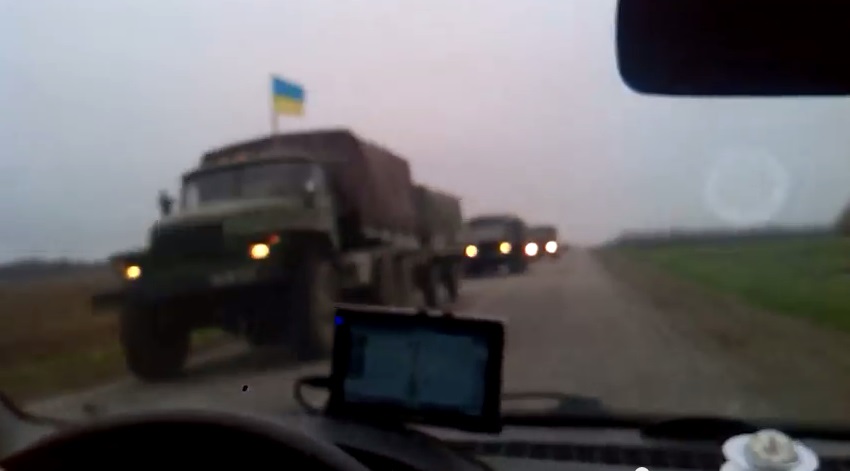
Therefore it has nothing to do with Donetsk or even this year — and cannot support the claims that Ukraine has sent Grads to Donetsk.
Should it make any difference, if it is footage of a Ukrainian military convoy headed for what appears to be combat anyway?
Yes, because it’s shorn of context — in the manner of much of Russian disinformation about the war. Ukrainian forces weren’t attacking Mariupol out of the blue that day in 2014; they were racing toward a city which, like many others in the Donbass in these early days of the war, had seen its administrative buildings taken over by thousands of demonstrators and then armed people, as we wrote on our Ukraine Live blog last year on that date.
The Kiev Post wrote how pro-Russian demonstrators were occupying buildings in a number of cities including Mariupol. The Mariupol city web site had an announcement from the mayor that salaries and pensions couldn’t be paid until the occupiers left the building. Russia was on the eve of war — and in Ukraine there was “not a civil war but a regular war” as we wrote at the time, and battles ensued in which Ukrainian forces drove the Russian-backed separatist militants out of Mariupol and regained control — otherwise it would have ended up like Slavyansk did for a time under separatist control — and as so many other towns have now.
To return to the present, the Ukrainian Armed Forces may have Grad missiles on the move today and may have fired them, but the images presented don’t prove this and we didn’t find any others.
Eduard Basurin, the DNR defense minister, said that
in the towns of Velikaya Novoselka, Olginka and Borodichnoye, Grads, Uragans, and Smerch trucks were spotted.
We couldn’t find any posts or images to support this claim, although we found an identical claim from a pro-Russian Twitter account a year ago:
Translation: DNR Intelligence: in the area of Velikaya Novoselka and Olginka, MLRS BM21 Grad and MLRS 9K57 Uragans have been deployed.
The conflict reporter @loogunda from Lugansk News Today was skeptical of the TV Zvezda reports because he had reported outgoing shelling from Donetsk the previous day which would indicate firing from separatists’ positions as they control Donetsk. Like a number of people watching these scenes play out day after day, he believed that the Russian-backed separatists stage scenes that appear to be shelling from Ukrainian positions solely for Russian TV disinformation.
While there may have been incoming shells from Ukrainian positions, we don’t see any pictures or videos to prove this, and the images used by TV Zvezda and other state media have been taken from last year from other places.
Meanwhile, citizen’s video uploaded today showed tanks in Donetsk. The footage was not clear enough to tell if they were Russian tanks, but that was the claim.
— Catherine A. Fitzpatrick
The Ukrainian Security Service (SBU) said the trucks were containing humanitarian aid that Russian-backed separatists were going to sell at higher prices on the black market.
According to a statement on the SBU web site (translation by The Interpreter):
The vehicles tried to cross the line of restriction to circumvent established checkpoints. Seven of the trucks detained by law-enforcers contained meat products, and the seventh contained various medicaitons. The drivers could not supply to officers of the special services any accompanying documents for the freight.
The SBU claims one of the leaders of the self-proclaimed “Donetsk People’s Republic” ordered the goods to be delivered with the intention of selling them at higher prices in their controlled markets.
The SBU does not explain what evidence was provided to make this claim, citing only “surveillance information.” A criminal case has been opened.
This is the sort of report that leads to charges that Ukrainian authorities are blocking humanitarian aid.
But so far neither Russia or the separatists it is supplying have complained. They would have to explain why they evaded checkpoints and had no bill of lading if in fact they had legitimate humanitarian freight.
— Catherine A. Fitzpatrick
Russian-backed separatists continue to shell the town of Stanitsa
Luganskaya, killing one civilian woman and destroying two homes, 0642.ua reported, citing the Lugansk governor’s office.
Starting
the night of Friday June 26 through Saturday morning, militants
pummeled the town without stop, using mortar-launchers, anti-tank guided
missiles and firearms. Shells exploded in the center of town among
other areas, damaging communications line.
One of the missiles stuck in the ground, unexploded, right near the
state administration building. Shrapnel also broke windows and flew
into the offices of the district administration. Two private homes on 1
May and Barbashova streets burned down after receiving direct hits from the
missiles.
One local woman on Donetskaya Street was killed in the shelling.
Power as well as water is out in Stanitsa Luganskaya and eight
neighboring villages, and communications are hindered. Power to this
part of the region is brought from Russia through the occupied
territory. City authorities have brought generators to some key
buildings and are distributing water via trucks.
Stanitsa Luganskaya is frequently targeted by militants
The last few weeks have been particularly fierce. On June 16, we reported that missiles struck near city administration building as well. As Moskal’s office reported on June 16 (translation by The Interpreter):
Stanitsa Luganskaya was stuck lats night by shells, grenade-launchers and firearms. In the center of town, about 15 meters from the regional administration building, the gas line is damaged on Lebedinskogo Street, and part of Stanitsa is without gas. Shells struck private homes on Lermontova St. which caught on fire. First-responders were able to put out the fire but the home is almost entirely ruined. Since the owners had already left in previous months, there were no casualties.

Home damaged June 16 in Stanitsa Luganskaya. Photo by moskal.in.ua
That story illustrated what has been true of many front-line towns — the owners fled earlier, and now they have nothing to come back to even if fighting dies down.
— Catherine A. Fitzpatrick
